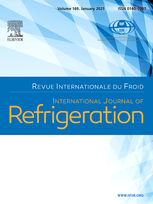
Summary
The pressure loss of the rotary exchanger is an important parameter that affects the energy consumption. Based on the literature review, the available correlations for calculating the pressure loss of rotary regenerative heat exchangers are presented in the article. The article presents extensive experimental research of rotary regenerative exchangers with different wheel geometries. A total of nine exchangers with eight different heat wheel geometries were investigated. The experiment was divided into two tasks concerning the pressure loss of the wheel channel and the total pressure loss of the built-in exchanger. The results of both approaches show differences that are caused by the leakage of rotary exchangers, which is their natural property. Based on the results
of the experiment, correlations were proposed for determining the coefficient of friction in a channel in the shape of a sinusoid and a correlation for calculating the total pressure loss of the built-in rotary exchanger. The presented correlations have been experimentally verified and can be applied with a sufficient accuracy of ±5%. The new correlations were compared with the published results. The article discusses the effect of leakage of exchangers equipped with a labyrinth seal. Based on the experimental investigation, it was found that the leakage of the examined exchangers varies in a wide range of 1 to 4% and depends on the quality of the exchanger construction.
Available documents
Format PDF
Pages: p. 364-377
Available
Public price
20 €
Member price*
Free
* Best rate depending on membership category (see the detailed benefits of individual and corporate memberships).
Details
- Original title: The effect of leakage on pressure loss of rotary regenerative heat exchangers.
- Record ID : 30032022
- Languages: English
- Subject: Technology
- Source: International Journal of Refrigeration - Revue Internationale du Froid - vol. 154
- Publication date: 2023/10
- DOI: http://dx.doi.org/10.1016/j.ijrefrig.2023.07.004
Links
See other articles in this issue (33)
See the source
-
Experiment on frictional pressure drop of conde...
- Author(s) : SONG T., WANG H., ROSE J. W., et al.
- Date : 2010/10
- Languages : Chinese
- Source: Journal of Refrigeration - vol. 31 - n. 5
- Formats : PDF
View record
-
Multi-objective optimization of a rotary regene...
- Author(s) : RAJA B. D., JHALA R. L., PATEL V.
- Date : 2016/01/25
- Languages : English
- Source: Applied Thermal Engineering - vol. 93
View record
-
Experimental study on flow condensation pressur...
- Author(s) : KUMAR R., SINGH D. K., CHANDER S.
- Date : 2023/10
- Languages : English
- Source: International Journal of Refrigeration - Revue Internationale du Froid - vol. 154
- Formats : PDF
View record
-
Experimental analysis for the determination of ...
- Author(s) : DALKILIC A. S., TEKE I., WONGWISES S.
- Date : 2011/01
- Languages : English
- Source: International Journal of Heat and Mass Transfer - vol. 54 - n. 4
View record
-
Thermal and hydraulic characteristics of multip...
- Author(s) : ABRAHAM P., SHARQAWY M. H., SHAWKAT M. E.
- Date : 2021/10
- Languages : English
- Source: International Journal of Refrigeration - Revue Internationale du Froid - vol. 130
- Formats : PDF
View record
